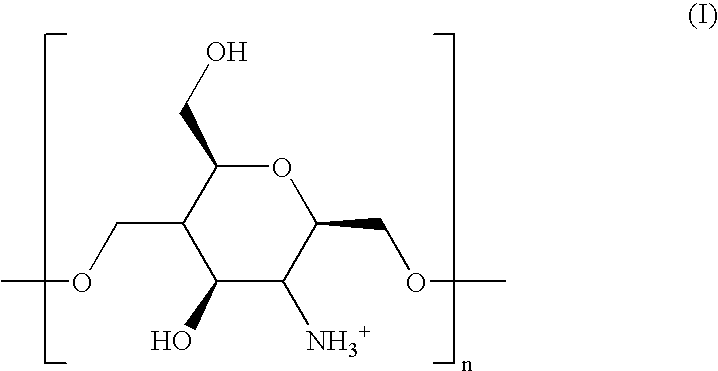Stable nanocapsule systems for the administration of active molecules
a nanocapsule and active ingredient technology, applied in the field of nanocapsule systems, can solve the problems of affecting the effect of adsorption,
- Summary
- Abstract
- Description
- Claims
- Application Information
AI Technical Summary
Benefits of technology
Problems solved by technology
Method used
Image
Examples
example 1
Stability Study of Chitosan Nanocapsules with Cyclosporine A in Suspension at 37° C.
[0104]Chitosan nanocapsules with cyclosporine A are prepared as described below:[0105]a) Preparation of the oil phase with 250 mg of lecithin, 0.5 ml of castor oil, 50 or 100 mg of cyclosporine A and 25 ml of acetone.[0106]b) Preparation of the aqueous phase with 50 mg of chitosan, 125 mg of poloxamer 188 and 100 ml of distilled water.[0107]c) Both phases are heated to 50° C., and then the organic phase is added to the aqueous phase, the nanocapsules spontaneously forming.
[0108]Then, the acetone is eliminated by applying heat (37° C.) in a vacuum and the remaining volume is then concentrated until 10 mL of water remains.
[0109]The nanocapsules resulting from that preparation have a nanometric size less than one micron, and more specifically between 200-700 nm, positive zeta potential (+10 mV-+70 mV), a cyclosporine A encapsulation efficacy of practically 100% (this was directly quantified after the de...
example 2
Stability Study of Chitosan Nanocapsules with Cyclosporine A to the Autoclave Process
[0112]Chitosan nanocapsules with Cyclosporine A were prepared according to the process described in example 1, and, then, an aliquot was subjected to an autoclave process (120° C. for 20 min). The main objective of this study was to evaluate if the size and potential of the nanocapsules had been modified during the autoclave process.
TABLE VICharacteristics of chitosan nanocapsules withcyclosporine A after an autoclave process (Mean ± SD)ZetaPresence ofConcentrationsizepotentialcyclosporinein external(nm)Z (mV)A crystalsaqueous phaseBefore the575 ± 5 +42.1 ± 0.7NOautoclaveprocessAfter the591 ± 11+46.2 ± 0.8NOautoclaveprocess
[0113]As can be observed in Table VI, after the autoclave process, the nanocapsules maintain their size and surface charge. Furthermore, after the autoclave process, no cyclosporine A crystals appear, which reveals that there is no significant release of the active molecule from t...
example 3
Stability Study of Chitosan Nanocapsules with Cyclosporine A Autoclaved in Suspension at 37° C.
[0114]Chitosan nanocapsules with Cyclosporine A were prepared according to the process described in example 1, then they were autoclaved following the process described in example 2, and they were stored at 37° C. for 5 months. With the objective of evaluating the stability of this system, particle size, zeta potential and the presence of cyclosporine crystals in the aqueous phase were measured at 1-month intervals.
TABLE VIICharacteristics of chitosan nanocapsules withcyclosporine A autoclaved and stored at 37° C. (Mean ± SD).Time atZetaPresence ofConcentration37° C.sizepotentialcyclosporinein external(months)(nm)(mV)A crystalsaqueous phase0591 ± 11+46 ± 1NO2635 ± 15+41 ± 1NO3506 ± 17+51 ± 1NO4485 ± 9 +47 ± 1NO
[0115]The nanocapsules with cyclosporine A, coated with chitosan, and autoclaved, are stable at 37° C. for, at least, 4 months (Table VII).
PUM
| Property | Measurement | Unit |
|---|---|---|
| size | aaaaa | aaaaa |
| size | aaaaa | aaaaa |
| size | aaaaa | aaaaa |
Abstract
Description
Claims
Application Information
 Login to View More
Login to View More - R&D
- Intellectual Property
- Life Sciences
- Materials
- Tech Scout
- Unparalleled Data Quality
- Higher Quality Content
- 60% Fewer Hallucinations
Browse by: Latest US Patents, China's latest patents, Technical Efficacy Thesaurus, Application Domain, Technology Topic, Popular Technical Reports.
© 2025 PatSnap. All rights reserved.Legal|Privacy policy|Modern Slavery Act Transparency Statement|Sitemap|About US| Contact US: help@patsnap.com

